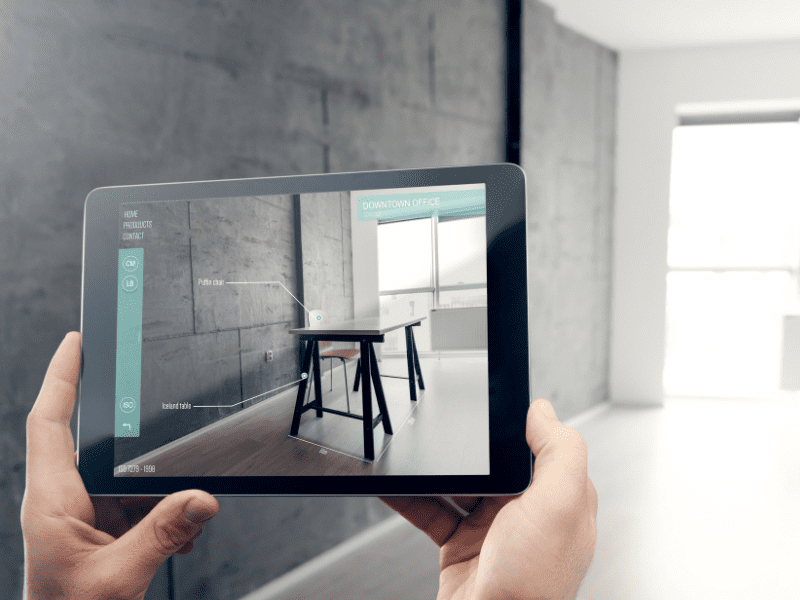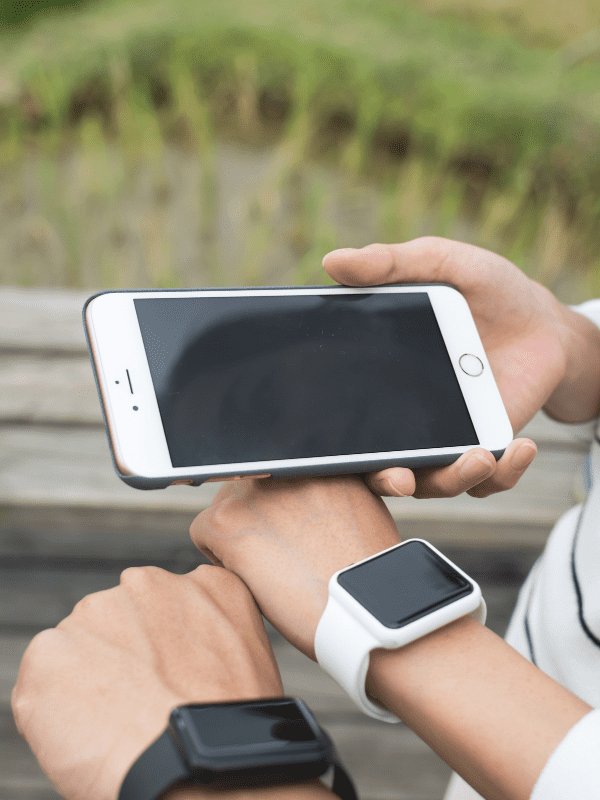Your Cheat Sheet to 2022’s Technology Trends 

By Franki Hanke
Sometimes, when a teenager starts talking about the most recent new technology trends, it can feel like for all the years I’ve been on this Earth I’ve learned nothing. With new, emerging technologies constantly appearing and evolving, it’s hard to keep up.
As we move towards peak barbeque season, here’s a handy primer for the new technology trends that might come up over dinner.

1. Artificial Intelligence
If you’re ever said “Hey, Siri!” or “Alexa!” to give a command, you’ve experienced Artificial Intelligence (AI). Artificial intelligence is when computers do tasks that usually humans would do. It involves programming a computer for complex tasks.
What’s the difference between Artificial Intelligence (AI) and regular computer programming?
Artificial intelligence “learns” over time. The initial program “trains” it, and then the AI can respond even in unfamiliar moments. Comparatively, a programmer has to tell the computer all the potential outcomes and how to respond.
What kinds of Artificial Intelligence (AI) are there already?
You’ve likely interacted with Artificial Intelligence already. Depending on how good it was, you might not have noticed.
→ Customer service online, like a text box, is often a “chatbot.” That is, an AI that’s trained to talk through common issues.
→ Self-driving cars, like the popular Tesla, use AI to follow road signs and identify common objects in the road like other cars, people, or construction signage.
→ Social media, like Facebook, use AI for facial recognition. When you upload a photo and Facebook guesses who to tag, that’s an AI trained in recognizing facial features.
Artificial Intelligence is getting better. The user experience with many chatbots is more natural, for example. As it gets better, we’ll see this type of programming involved in more industries. If you want to use an AI more in your everyday life, start maximizing the work Siri or Alexa can do for you!
2. Edge Computing
This sounds very futuristic, but it’s simple. Edge computing is one of the ways AI might improve user experience in the coming year. Here’s why:
Usually, most of the processing we do with devices is done via the “Cloud.” The Cloud is non-local storage through a data connection. So, instead of putting photos on a physical hard drive or floppy disk that you attach to your computer, you save photos on Google Photos. That means that the data for your photos is stored in a hosting center from Google.
So, if data is often stored in a hosting center and not on the device, there’s a slight delay. For example, if you ask your Echo, “What’s the weather today?” Here’s what happens:
You say, “What’s the weather today?”
Your device processes your voice with an AI process. It then represents your speech as data, similar to writing it down.
That data is sent to the cloud to be processed.
The data is processed to find the answer.
The data is sent back to your device.
Your device says, “The weather outside is…”
Now, it’s often so brief we don’t notice, but this process does create a delay. This delay is called “latency.” Latency means the time between a user’s action (you speaking) and the resulting response (Alexa saying “The weather outside is…).
The idea behind Edge Computing is to remove that delay by bringing the processing closer. In this example, that would mean putting an AI chip into your Echo device so it does processing on its own.

3. Augmented Reality
If you have ever used the preview feature in Amazon to see how an item looks in your space in real-time, you’ve used augmented reality. This technology adds digital elements over real-world elements.
This market is growing and we’ll likely see more examples of Augmented Reality next year.
Get The Finer Life
Our Sunday email has tips and content you will love – exclusively for our subscribers.
"*" indicates required fields
4. 5g networks
Right now, your cellphone runs on the 4G network. 5G options exist, but they are limited because it requires laying down new phone lines that are 5G compatible.
Once 5G is more widespread, it will mean faster data downloads and uploads. Essentially, 5G will make your phone work faster.

4. Personalized Healthcare due to Wearable Trackers
The rise of health data available in things like smartwatches could improve healthcare. Devices like the Apple Watch and Fitbit, which track activity levels alongside heart measurements have considerable data about our lifestyle.
As companies in healthcare integrate that information, we may see doctors using home trackers to inform their care. Ultimately, this should lead to more personalized medicine and better care.
For you, it also means you’re more informed. You have more power over your own health day-to-day when you can see what your lifestyle is like.
5. Automation Informed by Machine Learning
We’re big fans of the smart home concept. Using devices with connectivity to the main hub, we can automate things in our home like turning on three lights together with a voice command instead of flipping three switches manually.
Machine learning is part of Artificial Intelligence in that it’s a program “learning” how to do its job better or respond to new data. In the case of smart homes, we’re seeing this with the newest iRobot by Roomba. The new robot vacuum boasts that it will learn your homes’ cleaning needs and clean better. It can do this by gathering data (by vacuuming often and recording information like where it gathered more debris) and then using that data to change how it works.
For example, the new Roomba will vacuum more if it gathers debris often under the table where food is dropped and the dog sleeps. That automation (the vacuum) will get better because of machine learning.
Have you heard the term “Internet of Things?”
Home automation is related to the term “Internet of Things” or “IoT.” The idea is that as more devices connect to each other it creates a network between them like the network between sites. So, if your Amazon Alexa speaker can tell the Roomba robot vacuum to clean, they are connected. They are connected on an “Internet of Things.”
As this technology trend increases, we’ll likely see more business models built around connected functionality.
6. Cryptocurrency (like Bitcoin) and Blockchain
I won’t lie. This is a doozy. I’ve talked to people who run blockchain-based cybersecurity firms who can’t explain blockchain. So, if this flies over your head and doesn’t land for a few feet, it’s okay.
Let’s break it down. A cryptocurrency is a form of currency, like dollar bills or quarters. The difference is those are physical items that represent value ($1 and 25 cents, respectively). Cryptocurrency is a digital representation.
If you’ve heard of Bitcoin, it is just one example of a cryptocurrency. Last year, Bitcoin hit the news frequently, but it’s just one form of cryptocurrency.
Blockchain is involved in cryptocurrency exchange as a processing element. Blockchain, in a very simplified sense, is portions of data. Cryptocurrency is a digital currency made from portions of data.
Right now, people are debating whether this form of currency will become a new, major form of payment like regular cash payments.
7. Remote Work
During the coronavirus lockdown, almost all workforces switched to remote work. That is, people worked from their home computers instead of going into the office (or any workplace). Instead of filling boardrooms, we saw Zoom meetings and video conferences.
In the next year, as pandemic precautions soften, we’ll see companies adjust to having options again.
Many companies may adjust to prioritize remote work. It will come down to those with decision-making power, but many individual employees are eager to keep the flexible work style. For example, Microsoft adopted a new policy for a flexible workplace that allows up to 50% remote work from home after people experienced this work style during coronavirus lockdown.
8. Contactless Everything
This year, we saw Uber add contactless drop-offs. We saw e-commerce’s contactless options take over compared to in-store shopping. This year, it was a gut reaction to the coronavirus risks, however, these changes will likely stay.
The other technologies we’ve discussed, especially machine learning and artificial intelligence, make more services possible without human interaction. Pandemic changes will likely only be the start of fewer service interactions.
The tech landscape is diverse and constantly changing. New startups appear every day with big ideas that can rapidly change the course of our expectations, however, these topics are sure to appear in the news. Perhaps, they’ll come up over appetizers, and you can impress your quantum-computing-obsessed son.

Want a Free Guide?
You will receive our free 19-page guide and access to our exclusive content, private invitations, and tips you’ll love.
"*" indicates required fields
Facebook Group
